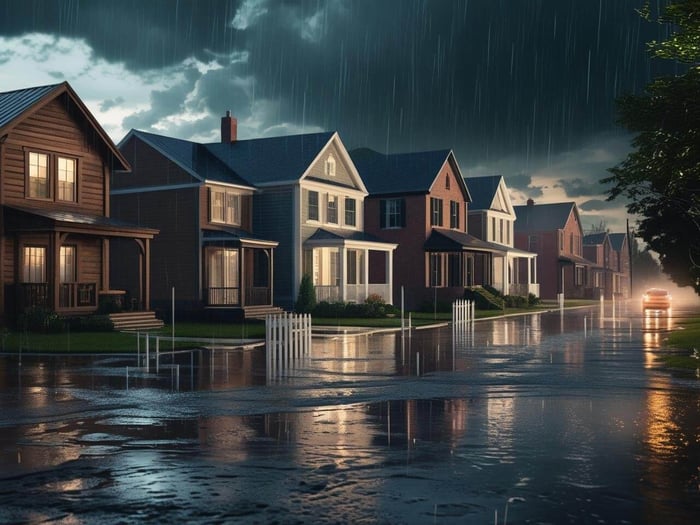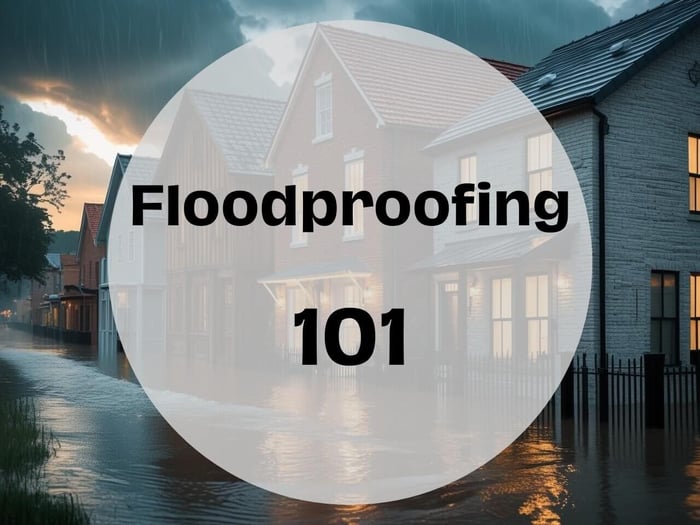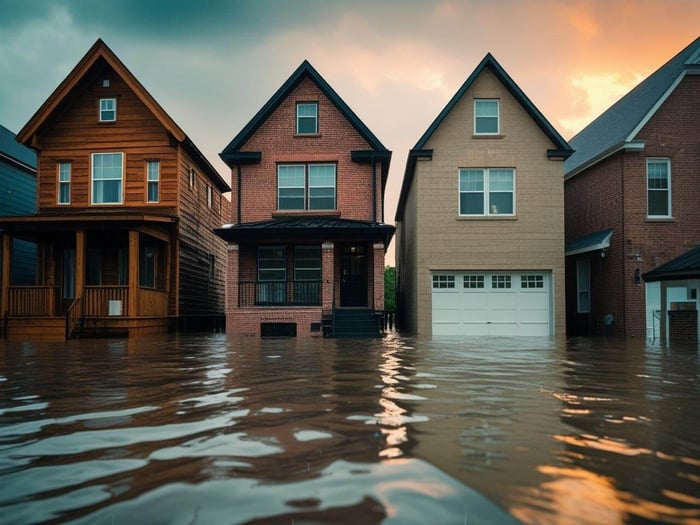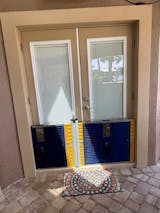Table of Contents
- What You’re Up Against: Florida Floodproofing Basics
- 1. Wood-Frame Homes
-
- 2. Concrete Block Homes (CMU)
- 3. Insulating Concrete Form Homes (ICF)
- 4. Structural Insulated Panel Homes (SIP)
-
- 5. Hybrid Homes (Block + Wood)
- Big-Picture Flood Defenses Everyone Can Use
- The Fastest, Easiest Seal for Doors & Windows
- Putting It All Together: A Simple Floodproofing Checklist for a Florida Resident
- 📌 Quick Flood-Ready Table for any Florida Home
- Why Waiting Isn’t Worth It
https://dameasyfloodbarriers.com/collections/dam-easy-product-familyLiving in Florida means sunshine, palm trees… and, for many of us, a fair share of flood risk. Between summer storms, tropical systems, and sea-level rise, it pays to know how your home is built, why it might be vulnerable, and what you can do—right now—to protect it. In plain English, here’s a homeowner’s floodproofing 101 guide to Florida construction types, what each one faces during a flood, and simple steps you can take (plus a low-hassle way to seal up doors and windows in minutes).
What You’re Up Against: Florida Floodproofing Basics
Florida floods in three main ways:
Storm Surge—Ocean water pushed ashore by a hurricane or tropical storm.
Heavy Rain—Days of nonstop downpours that overwhelm drainage systems.
Flash Floods—Sudden, intense storms that dump feet of water in hours.
All that water creates pressure on walls, foundations, and seals around doors and windows—and leaves a soggy mess if it gets inside. Let’s look at the five most common home types in Florida and what happens to each when water rises.

1. Wood-Frame Homes
What They Are
Imagine the classic “sticks and studs” house. Wood studs form the walls, joists hold up the floors, and rafters support the roof. This style is quick and cheap to build, so you see it a lot inland and in newer subdivisions.
Why They’re Vulnerable
Rot and Mold: Wood soaks up water, which leads to decay, mold growth, and even termite attraction.
Wall Buckling: As water builds up around a wood-framed wall, pressure can literally push it inward.
Fast-Water Damage: If a surge or flash flood hits, the framing simply isn’t as sturdy as concrete.
Easy Protections
Elevate: If you’re building new (or doing a big remodel), raise the lowest floor above the flood line.
Flood Vents: These little openings in crawlspaces let water flow under your home instead of pushing on walls.
Treated Materials: Use water-resistant sheathing boards and pressure-treated lumber below the expected water level.
Sealing Products: For doors and windows, consider quick-deploy barriers so you’re not scrambling when the next watch is issued.
2. Concrete Block Homes (CMU)
What They Are
CMU stands for Concrete Masonry Unit. In plain speak, that’s cinder or concrete blocks stacked, reinforced with steel rods, and filled with concrete. These are the homes that look like brick without the red color—very common along the coast and in South Florida.
Why They’re Vulnerable
Cracks Under Pressure: If the blocks aren’t properly reinforced, hydrostatic force from standing water can cause cracking.
Leaky Seams: Mortar joints and window/door openings can let water seep through.
Foundation Scour: Fast-flowing water can wash away soil under the footing, causing settlement or cracking.
Easy Protections
Reinforcement: Make sure your local builder follows code with vertical steel rebar in every block column.
Waterproof Coatings: A masonry seal or floodproofing paint can plug tiny pores in the concrete.
Flood Vents: These apply here, too—especially in any enclosed crawlspace or garage area.
Barrier Systems: Even a concrete home has entry points. A tested flood barrier at doors and windows is your last line of defense.
3. Insulating Concrete Form Homes (ICF)
What They Are
ICF homes use big interlocking foam blocks that you stack like giant Lego bricks and then fill with concrete. They combine sturdy walls with great insulation. Do they need floodproofing at all?
Why They’re Vulnerable
Openings: The walls themselves shrug off water, but doors and windows need extra care.
Seal Wear: Over time, seals around openings can degrade if not maintained.
Foundation Undercut: Same problem as block homes—soil washout under the slab or footings.
Easy Protections
Flood-Rated Doors: Choose doors tested to resist hydrostatic pressure.
Routine Checks: Inspect gaskets and seals around any openings every year, especially before hurricane season.
Barriers on Demand: A portable flood dam in front of your entrance delivers immediate protection without construction.
4. Structural Insulated Panel Homes (SIP)
What They Are
SIPs are factory-built panels: rigid foam insulation sandwiched between two structural boards (think super-insulated walls). They’re popping up in eco-friendly and modern-style houses.
Why They’re Vulnerable
Panel Seams: Water can creep in at the joints if not sealed properly.
Less Mass: They’re strong for insulation but don’t hold up as solidly against rushing water as concrete does.
Foundation Risks: Panel houses still sit on footings or slabs—same scour concerns.
Easy Protections
Professional Sealing: Have installers use floodproofing sealants on every seam.
Entry Barriers: Plastic, metal, or inflatable barriers on doors/windows add a quick, reliable layer.
Elevate Utilities: Keep your HVAC and major electrical gear up above expected flood levels.
5. Hybrid Homes (Block + Wood)
What They Are
Often you’ll see a concrete block first floor or foundation with a wood-frame second story. This balances cost savings with added strength where you need most of the floodproofing.
Why They’re Vulnerable
Transition Points: Where the wood meets the block, you can get leaks or structural weakness.
Upper-Story Risk: Once floodwaters reach the first floor, the wood-frame story above still faces buckling, rot, or mold.
Foundation Washout: The block base still needs proper footings and soil protection.
Easy Protections
Waterproof Transitions: Install flashing and sealants at the joint between block and wood.
Flood Vents Below: Keep the crawlspace or ground-level garage dry by letting floodwater flow through.
Barrier Upgrades: Whether the lower level is block or wood, doors and windows across both floors deserve fast-deploy floodproofing dams.
Big-Picture Flood Defenses Everyone Can Use
No matter your home’s style, these five steps deliver solid protection:
Elevation—If local code or your budget allows it, lift the lowest floor above the Base Flood Elevation (BFE).
Flood Vents—These code-approved vents let water enter and exit crawlspaces instead of slamming against your walls.
Flood-Resistant Materials—Sheetrock replaced by cement board on lower walls, treated wood, fiberglass doors—choose materials rated for wet conditions.
Utility Safety—Keep HVAC units, water heaters, and electrical panels up high or at least shielded against water.
Seal Every Opening— Doors, windows, garage doors, and even small service penetrations need a watertight barrier you can count on.
The Fastest, Easiest Seal for Doors & Windows
Let’s face it: sandbags are heavy, messy, and rarely seal perfectly. Even plywood panels can be hard to install and store. If you want a quick, reusable solution—one that takes minutes, not hours—Dam Easy flood barriers are a game-changer:
Tool-Free Deployment: No drills, no nails—just slot in the barrier and inflate or tighten the seal.
Under 5 Minutes: From box to fully sealed door in less than the time it takes to brew coffee.
Compact Storage: When not in use, these barriers fold down small—no garage filling up.
Reusable: Built to last through multiple seasons, so you’re covered flood after flood.
Modular: Got a double door or a wide garage? Stack or connect multiple units to fit any opening.
Whether your home is wood-frame, CMU, ICF, SIP, or a hybrid, Dam Easy barriers give you that last-line defense at every door and window—without the sweat and stress of sandbags.
Flood Barrier Door Dam - Ultimate Flood Gate

$949.00
DAM EASY® FLOOD GATE - DOOR DAM Floods are becoming more common around the world. What was once a 100-year phenomenon is now a seasonal trend that homeowners must deal with. That’s EXACTLY why you need this Dam Easy Flood… Read More
Putting It All Together: A Simple Floodproofing Checklist for a Florida Resident
Know Your Home
What style is it? (Wood, block, ICF, SIP, hybrid.)
Is it elevated above your street’s flood level?
Do you have enclosed spaces below the living area?
Layer Your Defenses
Elevate where possible.
Install flood vents.
Switch to flood-resistant materials on lower walls.
Raise or shield utilities.
Seal all doors and windows with Dam Easy barriers.
Practice Makes Perfect
Before hurricane season, run a drill: deploy your barriers, check vents, and test sump pumps.
Inspect seals and barriers annually. Replace any worn parts.
Stay Informed
Monitor NOAA weather alerts.
Keep an eye on FEMA flood maps if you’re buying or refinancing.
📌 Quick Flood-Ready Table for any Florida Home
| Task | Why It Matters | Action |
|---|---|---|
| Verify flood zone & BFE | Required by insurance, codes, and for safety | Check FEMA maps when buying/selling |
| Confirm elevation | Hydrostatic pressure kills structures below BFE | Consider raising slab or using fill |
| Install flood vents | Prevents crawlspace pressure buildup | Non-engineered or certified options |
| Use flood-resistant materials | Reduces rot, mold, and structural failure | Cement board, treated wood, fiberglass doors |
| Seal utility penetrations | Prevents pressure & water seepage | Caulk, backflow valves, reinforced conduits |
| Deploy Dam Easy barriers | Covers every weak opening fast | Order units + extension poles for wide areas |
| Maintain & test annually | Ensures all systems are flood-ready | Inspect seals, vents, deployment process |
| Get flood insurance | A must in high-risk zones | Shop around for best rates |
Why Waiting Isn’t Worth It
Floodwaters don’t knock first. Once a watch is issued, you might have only hours to save your home. Traditional solutions—sandbags, plywood, or construction panels—take too long and often leak. Damn Easy floodproofing barriers give you speed and reliability. They’re your secret weapon when every minute counts.
Final Thoughts
Florida’s building codes and modern materials do a lot to keep homes standing through storms. But no wall or elevation is 100% foolproof—especially at doors and windows. By understanding your home’s construction type, layering in vents and water-resistant materials, and keeping Dam Easy barriers on standby, you’ll be ready for whatever Mother Nature sends your way.
Protect your biggest investment—your home—your family’s safety, and your peace of mind. With a few simple steps and the right products, you can turn flood risk into flood resilience, one barrier at a time.




















